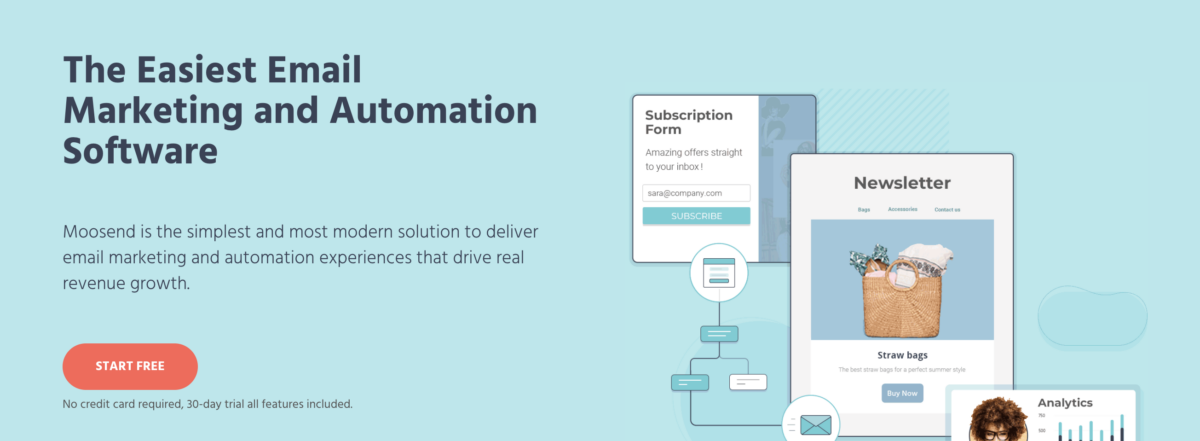Email marketing is a proven strategy for driving sales, traffic, nurturing leads, and building lasting customer relationships. You don’t need a huge budget to get started. There are plenty of powerful, free email marketing tools that can help you achieve your goals.
We’ll explore the top free email marketing platforms that deliver impressive features without costing you a dime. We’ll also delve into the benefits of email marketing and share tips on choosing the right tool for your unique needs.
- Zoho Campaigns
- Brevo
- Omnisend
- MailerLite
- Mailchimp
- Mailjet
- EmailOctopus
- Cleverreach
- SmartMail
- Hubspot
- Sender
- Moosend
- Benchmark Email
- Show less
You can trust Geekflare
Imagine the satisfaction of finding just what you needed. We understand that feeling, too, so we go to great lengths to evaluate freemium, subscribe to the premium plan if required, have a cup of coffee, and test the products to provide unbiased reviews! While we may earn affiliate commissions, our primary focus remains steadfast: delivering unbiased editorial insights, and in-depth reviews. See how we test.
Zoho Campaigns
Zoho Campaigns is an email marketing solution by Zoho that takes care of your email campaigns. To check the performance of your email campaigns, you get access to features like split testing, analytics reports, and more.

Features:
- Easy to use drag and drop editor
- Pre-built newsletter templates
- A/B testing
- Email Segmentation
- Contact list management
You can send up to 12,000 emails per month to 2,000 contacts with Zoho’s forever-free plan. However, if you want to automate your marketing process, you’ll need to upgrade to their premium plans.
Brevo
Brevo is a great free email marketing software if your email list is under 300 subscribers. It follows GDPR-compliant rules and offers a WordPress plugin to track your analytics data.

Features:
- Easy to use drag and drop email editor
- Support for email marketing
- Integrated CRM software for tracking customer interactions
- Official WordPress plugin for analytics
Brevo email solution is designed to help businesses of all sizes manage their email marketing campaigns efficiently. With its intuitive tools, users can create, automate, and track email campaigns while ensuring compliance with data privacy regulations.
With Brevo’s free plan, you can send 300 emails per day. Their premium plans start with the lite pricing plan, allowing you to send 20,000 emails monthly at just a $25 monthly fee.
Omnisend
Omnisend caters to multiple marketing channels like email and SMS marketing. It’s built with a vision to help eCommerce stores and therefore comes with single-click integrations with platforms like Shopify, BigCommerce, WooCommerce, and more.

With Omnisend, you can easily create automated marketing workflows to collect leads through popups and send emails, SMS, or push notifications.
Features:
- Ready made email templates
- Email option popups, landing pages, spin wheels
- A/B split testing for email campaigns
- GDPR consent forms
Their free plan allows you to send only 500 emails per month, which is comparatively lesser than other email marketing tools.
MailerLite
MailerLite is a relatively new tool in the email marketing ecosystem. However, the platform has gained good traction because of its clean UI design, highly targeted email settings, and integrations with popular tools like Zapier, Typeform, WordPress, and more.

Features:
- A/B testing, test email settings, and more
- Email template library
- Popup and form embedding features
Using the free account, you can store 1,000 contacts and send up to 12,000 emails per month. You can unlock MailerLite premium features like heatmaps and 24/7 live support by paying just $9 per month.
Take a look at our detailed review of Mailerlite to help you decide.
Mailchimp
Mailchimp is one of the most popular free email marketing platforms helping small businesses send professional-looking emails. It comes with a simple email builder that includes many pre-built templates. Basically, all you have to do is to customize these email templates to match your business requirements.
Features:
- Marketing CRM
- Email Segmentation
- WordPress plugin
- Plenty of integrations
- Free landing pages
With Mailchimp’s free plan, you can send up to 500 emails/day with an overall limit of 2500 emails per month. The free plan also provides you limited access to email segmentation capabilities, automation, and analytics dashboard.
Mailjet
Mailjet is a popular free email marketing tool known for its minimalist email templates, drag-and-drop email builder, and plenty of template preset modules. An advantage of the Mailjet free version is that you get access to APIs, SMTP relay, and webhooks for different integration purposes.

Features:
- GDPR-compliant subscription
- Clean and minimalist templates
- Integrations with Prestashop
- No cap on adding subscribers
With a daily email limit of 200, the free plan from Mailjet offers you 6000 emails every month. The premium plan will cost you $15 per month, unlocking all the premium features like email segmentation, validations, and online customer support.
EmailOctopus
EmailOctopus is a great email marketing tool for small businesses. Founded in 2015, the company’s primary aim is to offer affordable email marketing solutions. Their interface is simple and has more than 35 ready made email templates that can save you time from building emails from scratch.

Features:
- Pre-made templates
- Advanced email list segmentation
- Email builder
- Integration with 47+ apps
With EmailOctopus free plan, you can send up to 10,000 emails to 2500 contacts per month.
Cleverreach
CleverReach is the perfect tool for both beginners and email marketing professionals who want to see quick success. The simple setup, clever features, and partner-like service enable companies to have direct and personal communication with their customers.

Features:
- Responsive email templates
- Plenty of third-party integrations
- Drag and drop email editor
- GDPR-compliant email marketing
With Cleverreach’s free service, you can send 1000 free emails per month. Their premium plans start at $30 per month, offering you access to unlimited emails.
SmartMail
Email marketing by SmartMail is a fully managed “done for you” service that helps eCommerce companies maximize their return on investment. Unlike other free email marketing tools, it’s a service that helps you get the maximum return on your email marketing spending.

Some of their offered services are campaign management, email list building, setting up email automation, SMS marketing, and more.
Features:
- Dedicated email strategist
- On-brand template designs
- Strategy creation/direction
- Massive ROI
- Audience segmentation
Since it’s a service provider platform, you need to schedule a meeting from their calendar to get started with a personalized email marketing solution.
Hubspot
Hubspot is an all-in-one platform for handling your sales and content marketing needs. It’s more of a CRM platform that connects your email activities and customer responses in an intuitive dashboard for better communications.

This tool allows you to create forms, landing pages, and lead-generation opt-ins.
Features:
- Ad management
- Library of signup forms, pop-ups, and banners
- CRM support
- Access to email analytics reports
- Live chat and chatbots
Using Hubspot’s free plan, you can send 2000 emails per month. Since it’s a CRM, a good thing is you can check all the email interactions in a dedicated dashboard.
Sender
Sender on our list of free email marketing tools. It’s designed for small businesses that have a low budget for marketing but want to utilize the power of email marketing. Despite the low prices, the platform provides all the essential features like drag-and-drop builder, email analytics, segmentation, and web notifications.

Features:
- Built-in spam checking feature
- Automation workflows
- Tracking support with Google Analytics
- Plenty of popup forms, embeddable forms, and GDPR consent forms
- Built-in image library and image editor
With Sender’s free plan, you get a generous subscriber limit of 2,500 contacts and a monthly sending limit of 15,000 emails.
Moosend
The impact of sending a newsletter as a part of your marketing campaign is untouched. It is the easiest and quickest way to reach your customers’ inboxes and update them with recent happenings.

This is where Moosend comes into the picture, as it’s one of the easiest email marketing and automation tools you’ll come across. The automation processes are smooth and seamless, aimed at driving significant revenue growth.
Used by Vogue, Gucci, Isobar, Sephora, and other big brands, this email marketing solution boasts a range of features that can tailor your newsletter like fine wine.
Some features worth highlighting are the drag-and-drop email builder, detailed analytics report, marketing automation, and a range of templates you can choose to build your newsletter.
The automation, in particular, allows you to engage targeted audiences per your business needs. This feature is further boosted with segmentation and A/B testing for optimizing email performance. It’s a wonderful tool, as segmentation, if done right, hits the hammer on the nail.
| Pros | Cons |
|---|---|
| ✅ Advanced segmentation allows you to target customers with tailored content. | ❌ Might flag the wrong emails as bad sometimes. |
| ✅ Affordable pricing structures with a free version. | ❌ Limited third-party integrations. |
| ✅ Responsive and engaging customer support. |
The platform can be used for free, and you can upgrade whenever you’re ready. The plans can be availed annually or monthly, with the Pro plan priced at $6 per month. You can contact the sales team to get information about the Enterprise plan.
Benchmark Email
Winner of multiple awards, Benchmark Email will pinpoint exactly where you’re going wrong when email marketing and give you the tools to create stunning emails with a few clicks.

Moreover, you can send welcome emails, create automated triggered campaigns, build and maintain your email list, and more, all in one place. With the drag-and-drop editor, your job is made very simple.
You get 200+ templates clubbed with smart categorization. Before you send out your email/newsletter, you can try A/B testing to test your call to action, subject line, copy, and visual appeal.
If you’re feeling stuck, you can contact customer support via live chat, phone, or email. The tool also has certain design elements that can be used to build your newsletters, emails, and landing pages to add to the overall aesthetics of your marketing campaign.
Though the automations are not super advanced, they are excellent in getting your job done.
| Pros | Cons |
|---|---|
| ✅ 1500+ integrations with major technologies. | ❌ Limited free features. |
| ✅ A landing page builder with a lot of content options. | |
| ✅ Responsive email templates that work across all devices and screen sizes. |
Besides the free plan, you can avail its Pro plan at $13/month for up to 500 contacts. You can reach out to the sales team for more information on their Enterprise plans.
Is Email Marketing Important for Businesses?
Yes, email marketing is still an effective and personalized way of marketing. Email is the go-to communication platform for personal and professional use. It means you won’t see many irrelevant ads taking away your attention. Additionally, email as a medium adds trust because your message is personalized and not like long YouTube videos or cringy social media reels.
Email newsletter is a great way to keep your subscribers informed about your product updates, services and what’s happening around your business. It is a great way to keep your subscribers engaged because they are time-sensitive emails and personalized.
Limitation of Free Email Marketing Software
Free email marketing software is a good way to get it started and test the platform to understand how it works. However, it lacks features such as automation, number of emails you can send, number of contacts you can add, personalizing the emails and limited reporting.
When you are familiar with the platform and ready to invest on email marketing, you should consider email marketing software like Brevo, Omnisend, Convertkit and Intuit Mailchimp.

